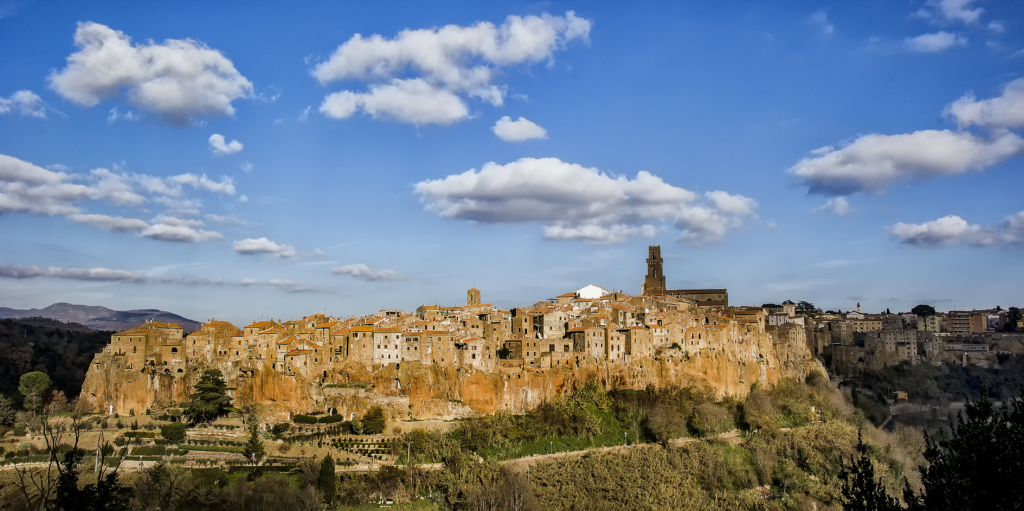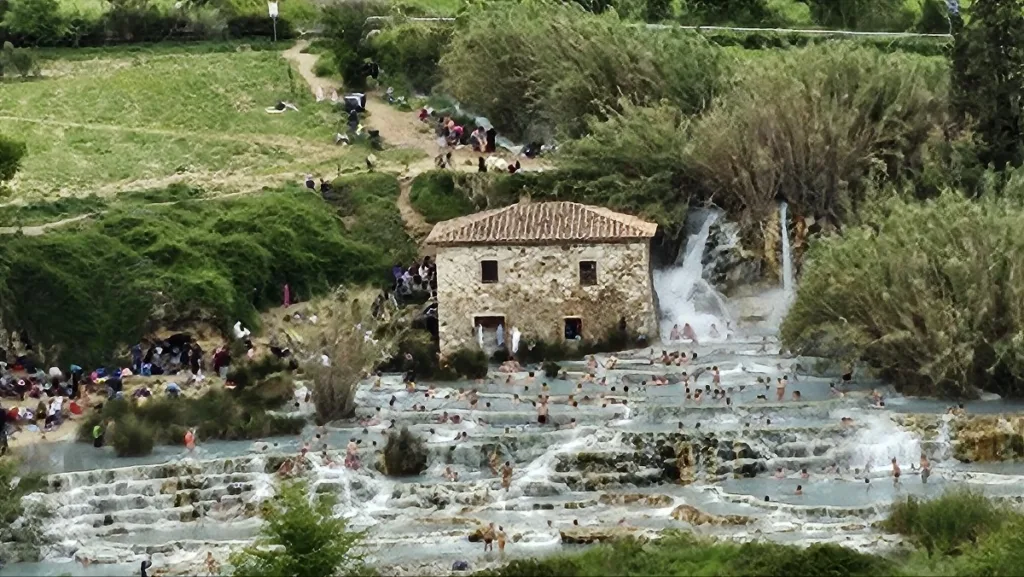
The Ultimate Tuscany Road Trip : 3-Day Itinerary
A Tuscany road trip would be the perfect alternative for those looking for a unique and richer experience than traveling by public transport in Italy. From Civita di Bagnoregio to Orvieto, Pitigliano, the Saturnia hot springs, Mount Amiata, the Val d’Orcia plains, Siena, and finally San Gimignano, this 3-day journey will allow you to enjoy breathtaking landscapes and the charm of medieval towns.
When Is The Best Time for Tuscany Road Trip?
When you think of Tuscany, the first image that comes to mind is the green fields of the Val d’Orcia. Therefore, the best time to visit Tuscany varies depending on the seasonal changes in these fields. The optimal time to see the beautiful landscapes of Tuscany is from mid-April to late May. After sowing in February, the wheat seedlings begin to sprout in March, reaching their full height from April. The wheat harvest starts in early June, leaving behind barren landscapes. This post records my visit to this area at the end of April, which was perfect timing.
Overview of the Entire Journey
The journey from Rome to Florence is relatively short—1 and half hour by train or about 3 hours by car. However, between these two cities lies a thousand years of history from the Roman Empire through the Renaissance, all tied together by the medieval era. I present to you a Tuscan road trip itinerary, where you can leisurely explore the diverse aspects of Tuscany, including mountains, plains, hot springs, cities, and rural villages.

Day 1 for Tuscany Road Trip : Departure from Rome, Civita di Bagnoregio, Orvieto, Pitigliano
After picking up your rental car in Rome, head to the first destination, Civita di Bagnoregio. Located about 140 kilometers from Rome, this town is famous for inspiring Hayao Miyazaki’s animation “Castle in the Sky.” When you face the castle perched atop a rocky hill in the middle of the basin, you’ll immediately understand the inspiration Miyazaki received. The bridge connecting Civita Castle to the town of Bagnoregio was built relatively recently in 1965.
Once called the “Castle in the Sky,” this place is now known to Europeans as the “Dying Town.” During its heyday in the Middle Ages, thousands of people lived here, but as of 2022, only 14 residents remain due to ongoing erosion causing the village to gradually collapse.

Next, drive about 20 kilometers to the larger town of Orvieto, perched on a volcanic cliff. The Etruscans, who were the local people of this area, built Orvieto and Civita as fortress towns to resist Roman invasions.
Orvieto is known for its underground cave city and the beautiful facade of its Duomo Cathedral. The slow food movement, which became the origin of modern slow cities, started here. Walking through the Orvieto fortress, you can feel the slow pace of life as if time has stopped for the locals who spend their daily lives inside the fortress.

The first place to visit is the Duomo Cathedral, which dominates Orvieto’s skyline. The facade of this Gothic-style building is filled with detailed reliefs and mosaics depicting biblical stories.

Next is the ancient underground cave city of Orvieto. These caves, initially dug by the Etruscans to supply water, evolved into an underground tunnel city, forming over 1,200 tunnels, stairs, quarries, storage rooms, and secret passages through various civilizations. Due to its natural fortification, it was also used as a refuge for the Pope during the Middle Ages.

Orvieto is a place that preserves the charm of a medieval city frozen in time. Walking slowly through its narrow streets and quaint buildings provides a sense of tranquility away from the hustle and bustle of modern life.

Now, conclude the first day and head to the medieval town of Pitigliano. Enjoy a leisurely evening meal in the romantic atmosphere of Pitigliano and spend a quiet night feeling as if you’ve stepped back in time. One tip: although this place is unfamiliar to foreign tourists, it is already popular among Italians. Most restaurants open at 7 p.m., and reservations are recommended as they tend to fill up quickly.


Day 2 for Tuscany Road Trip : Saturnia Hot Springs, Mount Amiata, Pienza, Agriturismo
On the morning of the second day, which feels like an overnight trip to the Middle Ages, we head to our first destination, the hot springs of Saturnia. On the way to Satrunia, there is a viewpoint with a panoramic view of Pitigliano, so don’t miss it.

About 20 kilometers from Pitigliano, Saturnia is a free outdoor hot spring. The mineral-rich sulfur hot spring water has been flowing continuously since ancient times, providing healing to many people who come early in the morning.

Next, cross Mount Amiata, the source of the Saturnia hot spring, towards the Val d’Orcia. Driving through the deserted roads of Mount Amiata, taking over the two-lane road, was an unforgettable experience. The fantastic views of the plateau that greeted me every time I stopped and got out of the car were a bonus.



Once you pass through the forests and several medieval towns, you will suddenly encounter the dreamlike scenery of the Val d’Orcia, the highlight of the Tuscan road trip. No explanation was necessary. I just share the breathtaking beauty of the Val d’Orcia plain.





Admire the breathtaking scenery of the Val d’Orcia plain, which changes every moment depending on the direction of the sunlight and the passing clouds. When you drive calmly through the picturesque Val d’Orcia, you will encounter another medieval town, Pienza.

Pienza, located in the valley below Montalcino, is a UNESCO World Heritage Site for its well-preserved Renaissance-era architecture and urban planning.

Next, we head to an agriturismo stay in the Tuscan countryside, where we can enjoy the peaceful ambiance. Here, we indulge in a traditional Italian homemade dinner made with fresh, locally-sourced ingredients from the farm. We spend our final night in Tuscany gazing at the star-filled sky.
For further information on the Agriturismo stay, please refer to the link below:
Agriturismo Tuscany, A Memorable Gataway
Day 3 for Tuscany Road Trip: Siena, San Gimignano, and Arrival in Florence
On the last morning of our Tuscany road trip, we wake up to the breathtaking views of the Val d’Orcia. We stop by a famous photo spot near our accommodation before heading to Siena, a city that encapsulates the rise and fall of medieval history.



The city of Siena, a jewel in central Italy, retains a rich history of medieval prosperity and decline. Once a fierce rival to Florence, Siena’s growth halted abruptly in the 14th century due to the plague. This pause in development has ironically preserved Siena’s medieval charm, captivating countless visitors today.
The Piazza del Campo of Siena
Our exploration begins at the heart of Siena, the Piazza del Campo. This fan-shaped square is dominated by the red-brick Palazzo Pubblico and the white-crowned Torre del Mangia. The square is divided into nine sections, representing the nine ruling families of Siena when it was built in the 12th century. The grandeur of this civic space reflects the city’s historical commitment to a balanced and inclusive political structure. Today, Siena is divided into 17 contrade (districts), each with its own flag and emblem, maintaining this centuries-old tradition.


Siena Cathedral
Siena’s halted growth is evident in the Siena Cathedral. Originally intended to be even grander than Florence’s cathedral, construction was abandoned due to financial difficulties, leaving the original nave as the current church and the intended main section as a mere façade. Had Siena continued its rise, the history of cathedral architecture might have been very different.



San Gimignano: The Medieval Manhattan
Next, we head to San Gimignano, the highlight of our Tuscany road trip, known as the “Medieval Manhattan.” Observing the common feature among all the small towns we’ve visited—tall towers—we learn that these Gothic structures served as beacons for villagers to locate churches from afar. San Gimignano, at its peak, had 70 towers; today, 14 remain, creating a stunning skyline that was the medieval equivalent of modern skyscrapers.

As our 3-day journey concludes, we drive to Florence, reflecting on the excitement and awe inspired by Tuscany’s diverse landscapes and rich history. I hope this narrative has conveyed the same sense of wonder and has inspired your future travel plans.

